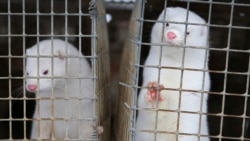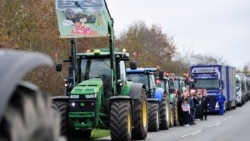Denmark says it plans to destroy its whole population of minks after the animals apparently spread the new coronavirus to humans.
Prime Minister Mette Frederiksen said government investigators had discovered a mutation in the virus in 12 people in northern Denmark. The individuals are believed to have been infected by minks.
Denmark’s health minister said that half of nearly 800 human COVID-19 cases in northern Denmark “are related” to minks. Denmark is the world’s main exporter of mink fur. Most of the fur is sent to China and Hong Kong.
Frederiksen called the situation “very serious” and warned that the mutation could make future coronavirus vaccines ineffective. Health officials said they found virus versions in humans and minks that showed decreased sensitivity to antibodies. They said this could make future vaccines less effective.
Frederiksen told reporters the mutated virus in minks could have harmful effects worldwide. “We have a great responsibility towards our own population, but with the mutation that has now been found, we have an even greater responsibility for the rest of the world as well,” she said.
To deal with the problem, the government said it was necessary to cull the country’s total population of 15 to 17 million minks. Officials said police and military forces would be deployed to speed up the process.
The discovery of the mutation was shared with the World Health Organization (WHO) and the European Centre for Disease Prevention and Control. The head of the WHO’s emergencies program, Mike Ryan, called for scientific investigations into how the coronavirus is being spread between minks and humans.
“We have been informed by Denmark of a number of persons infected with coronavirus from mink, with some genetic changes in the virus,” the WHO said in a statement to Reuters.
The WHO also provided a statement to the French press agency AFP. "In a few instances, the minks that were infected by humans have transmitted the virus to other people. These are the first reported cases of animal-to-human transmission," the statement said.
The U.S. Centers for Disease Control and Prevention states that coronaviruses “are a large family of viruses that are common in people and many different species of animals, including camels, cattle, cats, and bats.”
The CDC adds that “animal coronaviruses rarely infect people and then spread between people.” However, the organization said this happened with the new coronavirus, which causes the disease COVID-19. Scientists have said the new coronavirus likely started in bats and began spreading to humans at a market in China.
Danish officials say a total of 207 of the country’s fur farms had been infected with COVID-19. Denmark already started culling millions of mink last month in northern areas. The government has promised to compensate farmers for the losses. There are more than 1,000 such farms in the country.
The animal cause group Humane Society International praised the prime minister for taking a necessary “and science-based step to protect Danish citizens.” It said that such a large cull represents “an animal welfare tragedy.” However, the group said it hoped that losing so many mink to the coronavirus will persuade fur farms to get out of the business.
Danish officials said increased restrictions and stronger contact tracing efforts will be ordered in parts of the north to help contain the virus.
Kare Molbak is the director at Denmark’s State Serum Institute, the health body that deals with infectious diseases. “The worst case scenario is a new pandemic, starting all over again out of Denmark,” he said.
I’m Bryan Lynn.
The Associated Press, Reuters and Agence France-Presse reported on this story. Bryan Lynn adapted the reports for VOA Learning English. Mario Ritter, Jr. was the editor.
_________________________________________________________
Words in This Story
mutation – n. a change in the genes of a plant or animal that causes a difference from what is usual in that living creature
fur – n. the hairy coat of an mammal
cull –v. to control the size of a group of animals by killing some of them
transmit – v. to pass from one to another
species – n.(pl) a group of animals or plants that are similar and can produce young
compensate – v. to give money or something of value in return for some action, loss or damage
trace – v. to try to find someone or who they have met by collecting and studying evidence
scenario – n. a description of what could possibly happen












